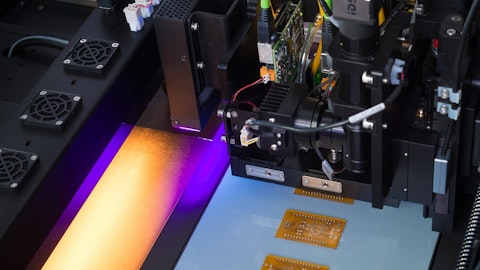In an interview with CNBC on October 14, Michael Kantrowitz, Chief Investment Officer at Piper Sandler noted that while the market is expensive, it’s not a reason to get bearish and that unless a risk arises, the market will likely stay expensive. Kantrowitz explains that the market’s valuation is driven by the pricing out of risks that existed two years ago, such as inflation and higher interest rates. He believes that if these risks were to resurface, it would be a reason to get worried, but currently, that’s not the backdrop.
He also notes that investors should focus on stocks with continued earnings momentum, as these names will likely see the best outperformance and can hold their expensive multiples for longer. Kantrowitz is not too concerned about higher bond yields but notes that they can be a problem at some point. He thinks that yields would need to reach 4.25% to show up in the broader market.
Regarding earnings revisions, Kantrowitz believes that revisions coming down have not overdone it and that it’s normal to see estimates from the sell-side start out high and then trickle down throughout the year. He expects to see more downward earnings revisions but notes that large-cap stocks have held up far better in terms of earnings, which is why they continue to outperform.
Tom Lee, Managing Partner and Head of Research at Fundstrat Global Advisors discussed the markets and his recent observations. Lee believes that the market’s resilience is due to the large amount of cash on the sidelines. He thinks that investors have been under-invested in stocks and that the market is becoming less dependent on macro data.
Lee pointed out that the market has been able to shrug off negative news and that the recent PPI and CPI reports were not enough to knock the market off track. He believes that the Fed will continue to be dovish, especially since inflation is still tracking towards the 2% target. Lee also thinks that the election, which is becoming less of a coin toss, is also contributing to the market’s conviction.
Regarding the impact of the election on the market, Lee believes that markets like visibility, but they also need to like what they see on the other side of the election. He thinks that whether Trump or Harris wins, stocks will do well next year, but there will be differences in sector and asset class performance depending on who wins.
While some may be concerned about the market’s expensive valuation, others see it as a sign of strength and resilience, with that in context, let’s take a look at the 10 most profitable stocks of the last 10 years.

Pixabay/Public Domain
Our Methodology
To compile our list of the 10 most profitable stocks of the last 10 years, we used the Finviz and Yahoo stock screeners to compile an initial list of the 30 largest companies by market cap. From that list, we narrowed our choices to companies with positive TTM net income and 10-year net income growth informed by reputable sources, including SeekingAlpha, which provided insights into 10-year growth rates, and Macrotrends, which supplied information on trailing twelve-month (TTM) net income. Our list is sorted in ascending order of the 10-year net income growth rates.
Why do we care about what hedge funds do? The reason is simple: our research has shown that we can outperform the market by imitating the top stock picks of the best hedge funds. Our quarterly newsletter’s strategy selects 14 smallcap and largecap stocks every quarter and has returned 275% since May 2014, beating its benchmark by 150 percentage points (see more details here).
10 Most Profitable Stocks of the Last 10 Years
10. ASML (NASDAQ:ASML)
10-Year Net Income CAGR: 16.30%
TTM Net Income: $7.30 Billion
Number of Hedge Fund Investors: 81
ASML (NASDAQ:ASML) is a Dutch company that manufactures advanced lithography equipment, which is essential for semiconductor production. As the sole supplier of extreme ultraviolet (EUV) lithography machines, ASML (NASDAQ:ASML) plays a crucial role in enabling the production of smaller, more powerful chips used in smartphones, computers, and other electronics.
On October 15, ASML (NASDAQ:ASML) reported its financial results for Q3, posting total net sales of $8.18 billion. The company achieved a gross margin of 50.8% and recorded a net income of $2.29 billion for the quarter. Additionally, the company reported quarterly net bookings of $2.83 billion, with $1.53 billion attributed to its EUV (extreme ultraviolet) lithography systems.
Looking ahead, ASML (NASDAQ:ASML) expects total net sales for the fourth quarter of 2024 to be between $9.59 billion and $10.03 billion, with a gross margin in the range of 49% to 50%. For the full year of 2024, the company anticipates total net sales to reach approximately $30.52 billion.
ASML’s (NASDAQ:ASML) technology is key to the advancement of Moore’s Law, making it a critical partner for the semiconductor industry. The company’s innovation and monopoly in EUV technology have driven its growth. With the AI revolution in full swing, ASML (NASDAQ:ASML) is poised for long-term outperformance due to strong demand for its equipment.
ASML’s (NASDAQ:ASML) strategic position in the semiconductor value chain makes it an attractive investment opportunity. Industry analysts are bullish on the company’s stock price and have a consensus Buy rating at a target price of $1,077.24, which implies a 38.38% increase from its current level.
9. Taiwan Semiconductor Manufacturing Company (NYSE:TSM)
10-Year Net Income CAGR: 16.52%
TTM Net Income: $29.91 Billion
Number of Hedge Fund Investors: 156
Taiwan Semiconductor Manufacturing Company (NYSE:TSM) is the world’s largest independent semiconductor manufacturer, playing a crucial role in the global tech supply chain by powering devices from smartphones to data centers. The company produces chips for leading global firms, including Apple, AMD, and NVIDIA. The company’s cutting-edge technology, particularly in advanced process nodes, has reinforced its position in high-performance computing and AI applications.
With a market share of nearly 30%, Taiwan Semiconductor Manufacturing Company (NYSE:TSM) remains a dominant force in the industry. The company’s advanced 2nm, 3nm, 5nm, and 7nm technologies and the latest innovations in 2nm and A16 process technologies are expected to further strengthen its market leadership.
Taiwan Semiconductor Manufacturing Company (NYSE:TSM) is also the manufacturer of Apple’s A16 chips, introduced in April 2024, which are designed for high-performance computing, featuring a complex signal route and dense power delivery network. Mass production is scheduled for the second half of 2026.
Taiwan Semiconductor Manufacturing’s (NYSE:TSM) 2nm (N2) process technology, which offers a 10% to 15% speed improvement at the same power or a 25% to 30% power reduction at the same speed, along with a more than 15% increase in chip density compared to 3nm chips, is anticipated to surpass 3nm and 5nm sales during their respective first two years. Volume production for this technology is set for 2025.
Taiwan Semiconductor Manufacturing’s (NYSE:TSM) advancements in 1.6nm and 2nm technologies give it a strong competitive edge. The company’s leadership in process technology below 7nm is expected to persist. The company is forecasted to grow its earnings by 23.61% this year. Industry analysts have a consensus on the stock’s Buy rating, with an average target price of $206.54 that suggests a 9.86% upside potential from its current levels.





